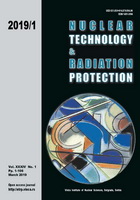
RADIOLOGICAL CONSEQUENCES ASSESSMENT OF A HYPOTHETICAL ACCIDENT DURING TRANSPORTATION OF SPENT NUCLEAR FUEL
Pages: 94-101
Authors: Bo Cao and Weijie CuiAbstract
During the transportation of spent nuclear fuels, the potential release of the radioactive materials into the atmosphere in the case of an accident becomes a serious threat to public health and the environment. In China, a commercial reprocessing plant is planned to be commissioned around 2025 based on the China nuclear roadmap. After being cooled on site the spent nuclear fuels are transported to the reprocessing plant by train or truck. This requires the assessment of radiological consequences of such accidents during transportation, therefore dose calculations under hypothetical accident conditions have been presented in this paper. The total effective dose equivalent and ground deposition are calculated using the HotSpot health physics computer code with site-specific meteorological conditions. The results indicate that the total effective dose equivalent and ground deposition are both decreased with the increase of the down wind distance. The maximum of the total effective dose equivalent is about 1.4 ×101 Sv, which is larger than the regulation limit for the public. The TEDE counter plot shows that the inner regions marked with dose contours of 1.0 ×10-3 Sv are higher than the regulation limits for the public, however this needs no intervention but any unnecessary trip to this area should be avoided.
Key words: radiological consequences assessment, atmospheric dispersion modelling, spent nuclear fuel, total effective dose equivalent, HotSpot
FULL PAPER IN PDF FORMAT (1,08 MB)
